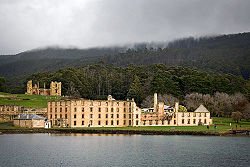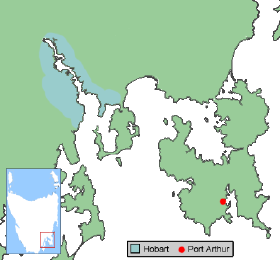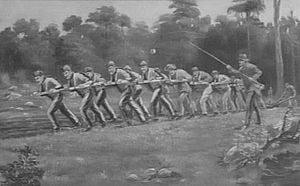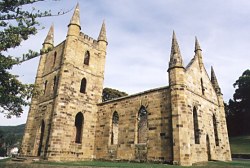Port Arthur, Tasmania
| Port Arthur Tasmania | |||||||
 The iconic view of the penitentiary originally built as a flour mill, across the water. | |||||||
| Population: | 499[1] | ||||||
| Established: | 1830 | ||||||
| Postcode: | 7182 | ||||||
| Elevation: | 192 m | ||||||
| Location: | •95 km SE of Hobart • 19 km S of Eaglehawk Neck | ||||||
| LGA: | Tasman Council | ||||||
| State District: | Lyons | ||||||
| Federal Division: | Lyons | ||||||
| |||||||
Port Arthur is a small town and former convict settlement on the Tasman Peninsula, in Tasmania, Australia. Port Arthur is one of Australia's most significant heritage areas and the open air museum is officially Tasmania's top tourist attraction. Known for its harsh conditions, dark history and stark beauty, it is located approximately 60 km south east of the state capital, Hobart. In 1996 it was the scene of the worst mass murder event in Australian history.
Location
Tasmania is an Australian island and a state of the same name, separated from the Australian mainland by the Bass Strait, a 240 kilometers (150 mi) wide stretch of water. Tasmania is known for its extreme natural beauty with spectacular mountain, lake, and coastal scenery. Nearly 37 percent of the state is protected in Nature Reserves and National Parks, including more than one fifth which is designated as UNESCO World Heritage Sites.
A settlement was established by Captain David Collins in 1804, in Sullivan's Cove on the western side of the Derwent, where fresh water was plentiful. This settlement became known as Hobart Town or Hobarton, later shortened to Hobart, now the state capital. Port Arthur is located approximately 80 kilometers (50 mi) southeast of Hobart. At the 2006 census, Port Arthur and the surrounding area had a population of 499.
History
Australia's largest penal station
Port Arthur was named after Van Diemen's Land lieutenant governor George Arthur. The settlement started as a timber station in 1830, but it is best known for being a penal colony.
From 1833, until the 1850s, it was a destination for the hardest of convicted British and Irish criminals, those who were secondary offenders having re-offended after their arrival in Australia. Rebellious personalities from other convict stations were also sent here, a quite undesirable punishment. It contains one of the best examples of a "Separate Prison" system based on that at Pentonville prison in London, The Separate Prison (or sometimes known as The Model Prison) was completed in 1853 and extended in 1855. The 80 cell prison was built in the shape of a cross with radial exercise yards around a central hall and chapel.[2] It signalled a shift from physical punishment to psychological punishment. It was thought that the hard corporal punishment, such as whippings, used in other penal stations only served to harden criminals, and did nothing to turn them from their immoral ways. Under this system of punishment the "Silent System" was implemented in the building. Here prisoners were hooded and made to stay silent, this was supposed to allow time for the prisoner to reflect upon the actions which had brought him there. In many ways Port Arthur was the pin-up for many of the penal reform movement, despite shipping, housing and slave-labour use of convicts being as harsh, or worse, than others stations around the nation.
In addition Port Arthur had some of the newest and strictest security measures of the Australian penal system. Port Arthur was secured naturally by shark-infested waters on three sides and the 30m wide isthmus of Eaglehawk Neck that connected it to the mainland was crossed by fences and guarded by prison guards and dogs. Contact between visiting seamen and prisoners was barred. Ships had to check in their sails and oars upon landing to prevent any unnotified leavings.
In 1836, a tramway was established between Taranna and a jetty in Long Bay, north of Port Arthur. The sole propulsion was convicts[3]
Port Arthur was sold as an inescapable prison, much like the later Alcatraz Island in the United States. Some prisoners were not discouraged by this, and tried to escape. Martin Cash successfully escaped along with two others. One of the most infamous incidents, simply for its bizarreness, was the escape attempt of one George "Billy" Hunt. Hunt disguised himself using a kangaroo hide and tried to flee across the Neck, but the half-starved guards on duty tried to shoot him to supplement their meager rations. When he noticed them sighting him up, Hunt threw off his disguise and surrendered, receiving 150 lashes.
Port Arthur was also the destination for juvenile convicts, receiving many boys, some as young as nine arrested for stealing toys. The boys were separated from the main convict population and kept on Point Puer, the British Empire's first boys' prison. Like the adults, the boys were used in hard labour such as stone cutting and construction. One of the buildings constructed was one of Australia's first non-denominational churches, built in a gothic style. Attendance of the weekly Sunday service was compulsory for the prison population, critics of the new system noted that this and other measures seemed to have negligible impact on reformation.
Despite its badge as a pioneer in the new nicer age of imprisonment, Port Arthur was still as harsh and brutal as other penal settlements. Some critics might even suggest that its use of psychological punishment, compounded with no hope of escape, made it one of the worst. Some tales suggest that prisoners committed murder (an offence punishable by death) just to escape the desolation of life at the camp. The Island of the Dead was the destination for all who died inside the prison camps. Of the 1646 graves recorded to exist there, only 180, those of prison staff and military personnel, are marked. The prison closed in 1877.
Today Port Arthur is home to many reputed cases of haunting and ghosts - particularly of convict origin. These include cases of cells with ghostly screams and empty rocking chairs that move.
From hellhole to haven: tourism development
After the closure of the penal colony the site was renamed to "Carnavon." During the 1880s the land in and around the site was sold off to the public and a community was established. Devastating fires tore through the area in 1895 and 1897 gutting the old prison buildings, leading to the establishment of the new town, with post office and other facilities.
Tourism started up almost as soon as the last convicts had left, supplying the new residents with a source of income, part of its undoubtedly due to its unsavoury past, and the ghost stories that accompany it. In 1927 tourism had grown to the point where the area's name was reverted back to Port Arthur. 1916 saw the establishment of the Scenery Preservation Board (SPB) which took the management of Port Arthur out of the hands of the locals. By the 1970s the National Parks and Wildlife Service began managing the site.
In 1979 funding was received to preserve the site as a tourist destination, due to its historical significance. The "working" elements of the Port Arthur community such as the post office and municipal offices were moved to nearby Nubeena. Several magnificent sandstone structures, built by convicts working under hard labour conditions, were cleaned of ivy overgrowth and restored to a condition similar to their appearance in the 19th century. Buildings include the "Model Prison," the Round Tower, the church, and the remnants of the main penitentiary. The buildings are surrounded by lush green parkland.
The mass graves on The Island of the Dead also attract visitors. The air about the small bush-covered island being described as possessing "melancholic" and "tranquil" qualities by visitors.
Tourists can either survey the site for themselves, or participate in guided tours, including late night "ghost tours." There is also a museum, containing written records, tools, clothing and other curiosities from convict times.
Since 1987 the site has been managed by the Port Arthur Historic Site Management Authority, funded by the Tasmanian Government.
Notes
- ↑ Australian Bureau of Statistics. 2006 Census QuickStats : Port Arthur (State Suburb) Retrieved January 20, 2009.
- ↑ The "Separate" or "Model" Prison , Port Arthur - Ian Brand ISBN 0-949457-33-7
- ↑ Gifford Eardley. April, 1954. The Convict Tramway at Port Arthur. Australian Railway Historical Society Bulletin pp3740.
ReferencesISBN links support NWE through referral fees
- Barrington, R. 1990. Convicts and bushrangers: stories of bygone years. Sydney: View Productions. ISBN 9780646022574
- Bennett, Richard, and Lucy Bennett. 1997. Port Arthur Tasmania. [Kingston, Tas.]: Good Intent Enterprises. ISBN 9780646316772
- Kneale, Matthew. 2000. English passengers. London: Hamish Hamilton. ISBN 0241140684
- Smith, Robin. 1987. The birth of a nation: Australia's historic heritage - from discovery to nationhood. Viking O'Neil. ISBN 0670900184
- Weidenhofer, Maggie. 1981. Port Arthur, a place of misery. Melbourne: Oxford University Press. ISBN 9780195543230
External links
All Links Retrieved January 20, 2009.
Credits
New World Encyclopedia writers and editors rewrote and completed the Wikipedia article in accordance with New World Encyclopedia standards. This article abides by terms of the Creative Commons CC-by-sa 3.0 License (CC-by-sa), which may be used and disseminated with proper attribution. Credit is due under the terms of this license that can reference both the New World Encyclopedia contributors and the selfless volunteer contributors of the Wikimedia Foundation. To cite this article click here for a list of acceptable citing formats.The history of earlier contributions by wikipedians is accessible to researchers here:
The history of this article since it was imported to New World Encyclopedia:
Note: Some restrictions may apply to use of individual images which are separately licensed.








